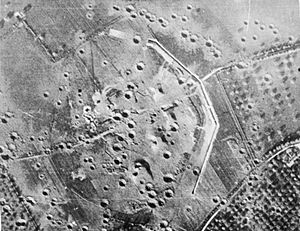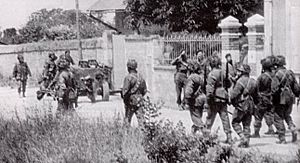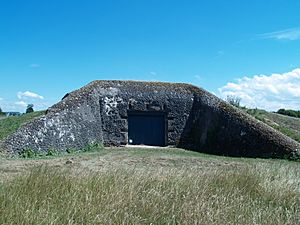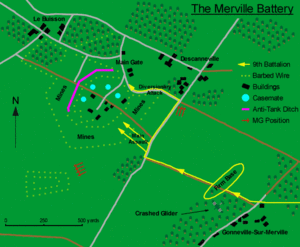Battle of Merville Gun Battery facts for kids
Quick facts for kids Battle of Merville Gun Battery |
|||||||
|---|---|---|---|---|---|---|---|
| Part of Operation Tonga | |||||||
 Overhead view of the battery, showing the damage caused by a bombing raid in May 1944 |
|||||||
|
|||||||
| Belligerents | |||||||
| Commanders and leaders | |||||||
| Units involved | |||||||
|
|
||||||
| Strength | |||||||
| 150 (assault force) 600 (in total) |
130 | ||||||
| Casualties and losses | |||||||
| 75 (during the assault) | 22 killed 22 captured |
||||||
| 450 men failed to arrive at the battalion assembly area following the parachute landing | |||||||
The Battle of Merville Gun Battery happened on June 6, 1944. It was part of Operation Tonga, which was a key part of the Normandy landings during World War II. The Allies (countries fighting against Germany) thought the Merville Gun Battery had very powerful guns. These guns could threaten the British soldiers landing at Sword Beach, which was only about 13 kilometers (8 miles) away.
The 9th (Eastern and Home Counties) Parachute Battalion, a British airborne unit, was given the job of destroying this battery. However, when the paratroopers jumped over Normandy, they were scattered over a huge area. Instead of over 600 men, only about 150 arrived at the meeting point. They also had no heavy weapons or equipment.
Even with so few men and no heavy gear, they bravely attacked. They managed to capture the battery! But then they found out the guns were smaller than expected. They were French 75mm guns, not the huge ones the Allies feared. Still, these guns could fire over 8,000 meters, which was enough to hit targets on Sword Beach. The 75 surviving soldiers used what explosives they had to try and wreck the guns.
After the British paratroopers left, German soldiers managed to get two of the guns working again. The next day, another British attack by British Commandos failed to take the battery back. The battery stayed under German control until August 17, when the German army began to retreat from the area.
Contents
Why Was the Merville Battery Important?
On June 6, 1944, the British 6th Airborne Division had a big job. They needed to protect the left side of the Allied landings by sea. One of their main goals was to destroy the Merville Gun Battery.
Allied planners had looked at the huge concrete bunkers built for the guns. They thought the guns inside must be very large, about 150mm in size. If so, these guns could shoot about 13 kilometers (8 miles). This distance meant they could hit the British soldiers landing at Sword Beach. This beach was just west of Ouistreham, where the British 3rd British Infantry Division was supposed to land later that day.
Who Attacked the Battery?
The unit chosen to destroy the battery was the 9th (Eastern and Home Counties) Parachute Battalion. They were part of the 3rd Parachute Brigade. Their commander was Lieutenant Colonel Terence Otway.
Normally, the battalion had 600 men. For this mission, they also had engineers from the 591st (Antrim) Parachute Squadron, Royal Engineers. They were supposed to get supplies like Jeeps, explosives, an anti-tank gun, and flamethrowers by Airspeed Horsa gliders. Three gliders, carrying 50 volunteers, were meant to land right on the battery in a surprise attack.
To prepare, the soldiers practiced a lot. In April 1944, they went to Walbury Hill in England. Engineers built a full-size copy of the battery, including its obstacles and barbed wire fences. The soldiers spent days learning the layout and practiced nine attacks, four of them at night. They even had extra medical support because the mission was so dangerous. Another unit, A Company of the 1st Canadian Parachute Battalion, was also there. They were to provide cover fire for the 9th Battalion as they approached and left the battery.
The attack had to be finished, and the battalion had to be gone by 5:00 AM. At that time, a British Navy ship, HMS Arethusa, was going to start firing its big guns at the battery to destroy it.
What Was the Battery Like?
The Merville Battery had four strong concrete bunkers, called casemates. Each bunker had walls about 1.8 meters (6 feet) thick, reinforced with steel. They were built by the Todt Organisation, a German engineering group. Each bunker was made to protect a 100mm gun from World War I. The site also had a command bunker, a building for the soldiers, and places to store ammunition.
On March 6, 1944, German Field Marshal Erwin Rommel visited the defenses. He told the builders to work faster. By May 1944, the last two bunkers were finished.
The battery was well-defended. It had a 20mm anti-aircraft gun and many machine guns in 15 different spots. The whole area, about 640 by 450 meters (700 by 500 yards), was surrounded by two barbed wire fences. These fences were 4.5 meters (15 feet) thick and 1.5 meters (5 feet) high. They also marked the edge of a 90-meter (100-yard) deep minefield. There was also an anti-tank ditch to stop any tanks coming from the nearby coast.
The first commander of the battery was killed in a bombing raid in May 1944. He was replaced by Oberleutnant Raimund Steiner. Steiner commanded 50 engineers and 80 artillerymen. These men were from the 1st Battery, Artillery Regiment 1716, part of the 716th Static Infantry Division.
The Attack Begins
Just after midnight on June 6, the first group of the 9th Parachute Battalion landed. They reached their meeting point without any trouble. While some men stayed to mark positions, Major George Smith and a small group went to scout the battery.
At the same time, British Royal Air Force planes started bombing. But they completely missed the battery! Their bombs landed further south. Meanwhile, the pathfinders (soldiers who jump first to mark landing zones) were having problems. Their special beacons were broken, and the smoke from the bombing made it hard for pilots to see their marker lights.
The main group of the 9th Parachute Battalion and their gliders were supposed to land at a specific drop zone. However, the paratroopers were scattered far and wide. Lieutenant Colonel Otway landed about 365 meters (400 yards) from the drop zone, right near a German command post! After a short fight, he and other scattered paratroopers reached the drop zone by 1:30 AM.
By 2:50 AM, only 150 men had arrived at the meeting point. They only had 20 Bangalore torpedoes (long explosive tubes) and one machine gun. All the important equipment like mortars, the anti-tank gun, mine detectors, jeeps, engineers, and medical teams were missing.
Knowing they were running out of time, Otway decided they couldn't wait any longer. The small group headed for the battery. They met Major Smith's scouting party just outside the village of Gonneville en Auge. Smith's group had already cut through the barbed wire and marked four safe paths through the minefield. Otway split his men into four attack groups. They waited for the three gliders to arrive.
Back in England, one glider's rope snapped in bad weather, and it landed at an airbase. The other two gliders couldn't find the battery. They were hit by anti-aircraft fire. One landed about 3.2 kilometers (2 miles) away. The other landed right at the edge of the minefield. The soldiers from this glider got into a fight with German troops who were heading to help defend the battery.
Otway launched the main attack as soon as the first glider flew past the battery. He ordered the explosives to be set off. This created two paths through the outer fence for the paratroopers to rush through. The explosions alerted the German defenders, who immediately opened fire. Many British soldiers were hit. Only four attackers made it to Casemate Four. They disabled it by shooting into openings and throwing grenades inside. The other bunkers were cleared with grenades, as the German crews had forgotten to lock the doors. During the earlier bombing raid, the guns had been moved inside the bunkers, and the steel doors were left open for air.
During the battle, 22 German soldiers were killed, and about the same number were captured. The rest of the German defenders escaped by hiding in underground bunkers.
Steiner, the German commander, was not at the battery during the bombing. He was at a command bunker nearby. After the bombing, he tried to get to the battery, but the British paratroopers were firing too much. At the same time, a German patrol with a half-track vehicle and a large anti-aircraft gun arrived. They had planned to take cover at the battery, but instead, they used their gun to fight the paratroopers.
The British now held the battery, but they had no engineers or proper explosives. They gathered what little plastic explosives they had from their Gammon bombs to try and destroy the guns. By this time, Steiner had returned to his command post. He ordered his other gun batteries to fire on the Merville Battery.
What Happened Next?

Just before 5:00 AM, the remaining British soldiers, only 75 out of the 150 who started, left the battery. They headed for their next target, the village of La Plein. The battalion was too small and weak to fully capture the village. They had to wait for the 1st Commando Brigade to arrive later that day to finish the job.
After the British left, the Germans took back control of the battery. Steiner couldn't see Sword Beach from his command bunker. So, even though he got two of his guns working again, he couldn't aim them accurately at the landings. However, German observers closer to the beach could guide his guns until their position was taken by the Allies.
On June 7, the battery was attacked again. This time, two groups of commandos from No. 3 Commando tried to take it. But the attack happened during daylight and was pushed back. The commandos suffered heavy losses. As they retreated, the battery's guns fired directly at them.
The British never fully destroyed the battery. It stayed under German control until August 17. That's when the German Army began to pull back from France.



